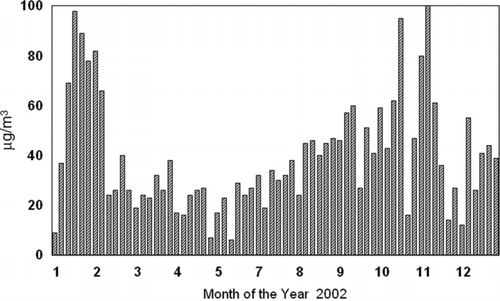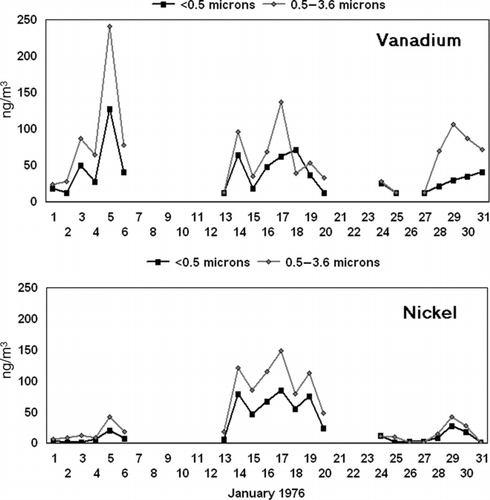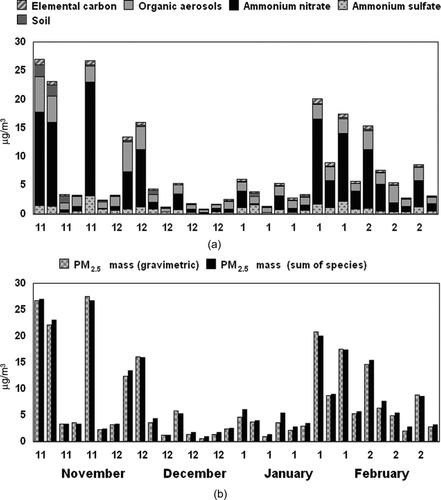Abstract
The southern part of Central Valley of California in winter has long had high PM10 mass, which until about 1990 included sulfate, vanadium, and nickel from the burning of crude oil used to generate steam to enhance heavy petroleum recovery. In roughly 1990, natural gas became the major energy source used for steam generation. In 1989–1991, data were collected throughout California on the mortality from strokes and ischemic heart disease (IHD). Although no spatial variability was seen for strokes, the southern San Joaquin Valley was found to have IHD mortality rates roughly 60% greater than the rest of the valley. PM10 was statistically identified as the major factor associated with the IHD mortality. However, when the rate of IHD was reexamined in the 2003–2007 period, a sharp reduction, about 30%, was seen in the relative rates for southern San Joaquin Valley as compared with the northern Sacramento Valley. We have measured very fine and ultrafine vanadium and nickel aerosols in a winter experiment in 2009, which shows an order of magnitude reduction in vanadium and nickel aerosols as compared with the pre-1990 data, which is a consequence of the switch from burning crude oil to natural gas to generate the steam. The inference of a causal relationship between the reduced vanadium and nickel and the improved IHD rate is supported by a growing body of laboratory and epidemiological work on the toxicity of vanadium and nickel, including from oceangoing ships burning crude or residual oil.
INTRODUCTION
The Central Valley of California is well known for exhibiting in much of its area serious violations of federal PM10, PM2.5, in winter, and ozone standards, in summer, matching or exceeding those seen for any commensurate area of the United States. Yet other parts of the valley share agriculturally based land uses and meteorology and do not exhibit serious violations of these standards. Although efforts continue to control particulate matter (PM) and ozone violations, this pollutant gradient offers an ideal situation to examine the effects of pollutants on health. Many of the confounding variables seen in comparison studies, such as meteorology, land use patterns, and cigarette smoking, are very similar throughout the Valley, and a wealth of data exists on the pollutants and their sources from district air monitoring and Air Resources Board (ARB) studies. The presence of detailed analysis of mortality from ischemic heart disease (IHD) and stroke during 1989–1991 reported by the Cardiovascular Disease Outreach and Epidemiology (CORE) Program (Kao et al. 1994) and the California Department of Health Services (CADHS 2010) provides a natural opportunity to compare the pollutant data and mortality data for the identical time ranges. While this article focuses on PM effects, the original report (Cahill et al. Citation1998) also examined the effects of ozone and carbon monoxide (CO) on IHD and stroke mortality; some of which are presented in this article for completeness. However, complexities in the spatial and temporal gradients of ozone require further interpretation, and thus, they are not examined in any detail in this article.
BACKGROUND
The northwest-southeast trending 550 km by 100 km Central Valley of California is one of the richest agricultural areas in the world (). In addition, there are two major metropolitan areas in the Valley, the Sacramento-Fresno regions each with about 1 million residents, and otherwise towns are generally medium (circa a few 100,000) to small and spread throughout the Valley. The mean population density is about 60 people/km2.
FIG. 1 Map of the Central Valley of California. The northern part is referred to as the Sacramento Valley while the southern part is called the San Joaquin Valley. The areas within the dotted circumference vary in altitude from almost sea level in the Delta to a few 100 m in elevation. The small arrows denote the typical winter wind patterns (Hayes et al. Citation1984).
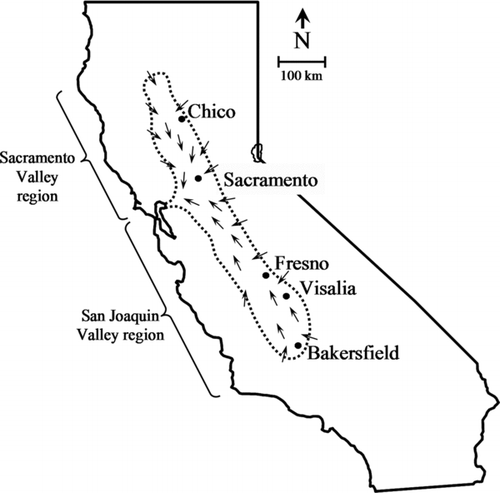
High summer temperatures in the Valley (mean daily high, July, 36°C ± 1°C) lower the surface pressure and draw massive inputs of cool air into the Valley from the San Francisco Bay area, bringing with it oceanic aerosols and typical urban pollutants enhanced by the major petrochemical industrial sites at the Carquinez Strait. These latter sources lie directly in the path for the cold, dense winds from the San Francisco Bay. These winds funnel down the entire San Joaquin Valley, south of the strait, but rarely penetrate north very far in the Sacramento Valley, north of the strait. Rainfall in the Valley is rare during the period from May through October.
In winter, there is slow drainage of cold air off the Sierra Nevada to the Valley floor (mean daily low, January, 3°C ± 1°C) and then, at the rate of about 50 km/day, the air drains toward the lowest point, the Sacramento–San Joaquin Delta, directly east of the Carquinez Strait. Thus, little impact from the San Francisco Bay area is seen on most winter days in the Central Valley beyond the immediate Delta region. Winter rainstorms and strong northwest winds periodically clean out the Valley. Thus, the Valley tends to fall into two distinct and very different conditions: hot, dry summers with strong diurnal winds, and cool, foggy winters with long periods of stagnation. This results in two very different aerosol types: summer and winter ().
In , 24 h, one day in six PM10 mass at the Fresno 1st Street “Super-site” is shown (ADAM 2010). The site is in a largely residential neighborhood roughly 1 km east of the nearest major freeway, well away from agricultural operations. It is thus a good representation of what the average Fresno resident inhales. The annual pattern of PM10 mass has been consistent in the valley for many years, but this data only really became available around 1997, hence why uses more recent data to demonstrate the traditional annual cycle of particulate mass.
The health effects data are derived from CORE (Kao et al. 1996) and CADHS (2010). CORE collected city (>20,000 inhabitant) and countywide data on mortality from stroke and IHD; the latter is the largest source of mortality in the California Central Valley accounting for about one fourth of all deaths. The CORE data were corrected for age, >35 years, and reduced to incidence per 100,000 residents. The results were then presented as a ratio to the California average values the both males and females. Individual city data were weighted and averaged to obtain countywide averages in order to match the air pollution data.
The effect of race was examined over the entire California dataset. The data were available only in three classifications: “White,” “Black,” and “Other,” with “Other” in the Central Valley being largely Latinos. No statistically significant difference was seen in the IHD rates for the dominant >75 years age group, but a slight enhancement of the rates for Blacks was seen in the 64- to 75-year cohort. For all ages, the mortality/100,000, 95% confidence limit, was 196 ± 3 for white males, 212 ± 9 for black males, and 199 ± 4 for other males; the corresponding values for females were 127 ± 3, 166 ± 5, and 135 ± 3. The stroke deaths, on the contrary, while only roughly one third of the rate of IHD mortality, showed stroke rates roughly twice as high for the “Black” and “Other” cohorts than the “White” cohort. Consideration was given to cigarette-smoking patterns, but no significant difference was seen along the length of the Valley ().
TABLE 1 Ischemic heart disease (IHD) and stroke mortality versus air pollutants in the Central Valley of California, 1989–1991
Four metrics for air pollution were studied, each with very different cardiovascular impacts: ozone (top 30 h and hours above 0.09 ppm), annual average CO, and annual average PM10. The approximate cigarette-smoking patterns were calculated from cigarette sales data. Correlations were calculated for all parameters and are presented in and Figures and . At some sites, measurements were lacking. No data were deleted.
TABLE 2 Correlation of air pollution to mortality by IHD and stroke in the Central valley of California, 1989–1991
To further investigate the statistical robustness of these data, we used “proc glm” on SAS version 9.1 for the analyses. Because there are only 13 observations in total, we did not feel that imputation would prove fruitful. Therefore, we ran multiple regression models with “percentage change of IHD” and “percentage change of stroke” as the outcome variables. The possible explanatory variables were “number of hours of ozone above 0.09 ppm” (“ozone”), “annual average PM less than 10 μm, measured in micrograms per cubic meter” (“PM10”), and “percentage rate of smoking” (“smoking”). We checked the assumption of normality of the errors by formally using the Shapiro–Wilk test and the assumption of homoskedasticity informally using residual plots.
The overall stroke model was not significant (p = 0.1108). We did not proceed further for that outcome. However, the overall IHD model was significant (p = 0.0330). We used backward elimination as the model selection strategy, for example, that of Neter et al. (Citation1996). Ozone and smoking were eliminated—in that order—leaving PM10 as the sole significant explanatory variable (p = 0.0026). The resulting linear regression is given by
However, the strong association between aerosol mass and IHD posed a problem. As additional data were developed in the Central Valley from the IMPROVE program (Malm et al. Citation1994) and from extensive California studies (CRPAQS Citation2001, Cahill et al. Citation2003), it became clear that the major aerosol species that dominated fine mass was ammonium nitrate, with much smaller contributions from organic matter, including a wood smoke component, and ammonium sulfate. These are however water soluble and have not been closely linked to IHD in animal and laboratory studies. (Devlin Citation2003; Lippmann Citation2009).
FIG. 3 Comparison of death rate from IHD, compared to the California average, and annual PM10 inhalable aerosol mass. Shasta County is at the very northern end of the California Central Valley, and Kern County is at the southern end.
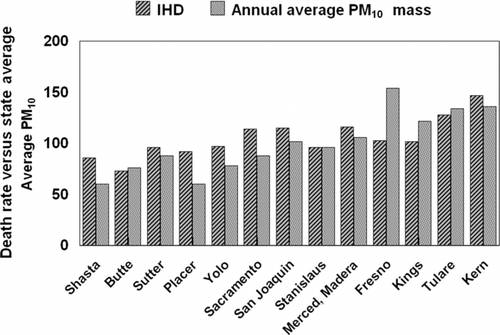
FIG. 4 IHD mortality rate relative to the California average versus PM10. The parameters are associated by a regression r 2 = 0.56.
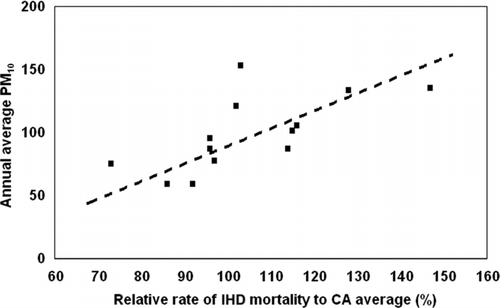
Reduction of IHD Rates: 2003–2007 Versus 1989–1991
Beginning around 1999, data on aerosol in the Central Valley were enhanced by the availability of PM2.5mass and chemical speciation at some San Joaquin Valley sites. In , the same period for the , one day in six PM10 mass is shown for 24 h daily fine PM2.5 mass (ADAM Citation2010). The old federal 24-h PM2.5 standard was 65 μg/m3 and the current 24-h standard is 35 μg/m3, which is routinely violated in winter. The annual average standard is 15 μg/m3.
FIG. 6 IHD in the California Central valley, 1989–1991 versus 2003–2007. The 1989–1991 data are scaled to match the Shasta–Butte data, 2003–2007, as diagnostic protocols differed.
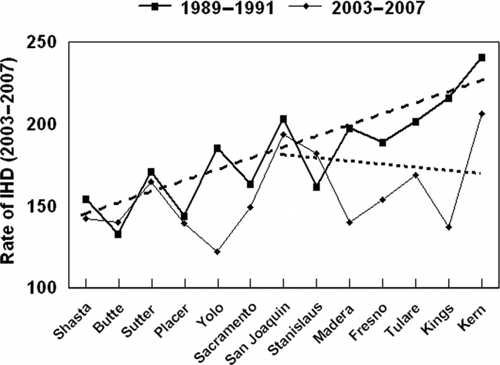
The question of IHD and aerosols was revisited for the period 2003–2007 (Cahill et al. Citation2010). From the recent data, it became clear that a comparison of the IHD mortality, 1989–1991 versus 2003–2007, shows a major reduction, roughly 30%, that occurs in 2003–2007 for the counties north of Bakersfield (). The trend for the northern half of the Central Valley is similar, while Bakersfield in Kern County is only slightly reduced. Thus, the question arises as to the causes for the improvement in the IHD rate.
The compositional analysis of Central Valley aerosols dates back to the early 1970s, including an innovative program of UC Davis for the California Air Resources Board (CARB), 1973–1977 (Cahill et al. 1974; Flocchini et al. Citation1976; Barone et al. Citation1978; Motallebi et al. Citation1990a, 1990b). A total of 14,100 daily aerosol measurements were taken in three size modes (15–3.5 μm, 3.5–0.50 μm, and 0.50–0.0 μm) and analyzed for elemental content by particle-induced x-ray emission (PIXE) (Cahill Citation1995) at about fourteen separate sites, including the valley sites of Chico, Sacramento, Visalia, (100 km NNE of Bakersfield), and Bakersfield. Bakersfield had one of the highest levels of vanadium and nickel aerosols in California, but port areas (Oakland, Richmond, and Los Alamitos) were also high ().
Neither vanadium nor nickel was seen in sizes above 3.5 μm diameter. The radically different vanadium/nickel ratios occurred when winds came from the western (Taft, 40 km SW) or northern (Oildale, 5 km N) oil fields periods of stagnation, giving the highest pollution levels, favored sources in the much closer northern oil fields, some of which were within Bakersfield itself (Motallebi et al. Citation1990b). In addition, there was an oil refinery in Oildale, with potentially different emissions than the crude oil burned for enhanced oil recovery (EOR). Also it is noteworthy that while the vanadium and nickel concentrations can vary by over an order of magnitude, the lead levels were relatively constant, indicating a continuous impact of traffic-derived aerosols at Bakersfield.
Recent compositional analysis of the PM2.5 aerosols in the southern San Joaquin Valley also became available through the IMPROVE site at Sequoia National Park (NP) starting in 1992 (Malm et al. Citation1994). The Sequoia NP Ash Mountain site was at low elevation, near 600 m, and thus received aerosols from the valley floor whenever the inversion lifted to that level.
IMPROVE had anticipated the value of PM2.5 mass and full speciation, using quality assurance protocols of “integral redundancy” to measure major parameters by two or more independent methods. Sulfur from PIXE on Teflon in Channel A (Cahill Citation1995) is compared with sulfates after a denuder on Nylon filters in Channel B. Organic matter measured by combustion from tandem quartz filters in Channel C is compared to organic matter estimates by nonvolatile hydrogen of Teflon in Channel A (Cahill et al. Citation1989). Iron was measured by both PIXE and x-ray fluorescence (XRF) on the Teflon filters of Channel A. Thus, the gravimetric mass can be directly compared to the sum of all species () and all major components ().
FIG. 9 Lead and sulfur, 1974–1976, versus sulfur, 2009, and vanadium, nickel, and zinc 1974–1976. Visalia lies between Bakersfield and Fresno.

shows periodic incursions of high aerosol levels throughout the winter whenever the valley inversion rises to the altitude of Ash Mountain. Other than during these incursions, aerosol mass levels are very low, a few μg/m3. By choosing an arbitrary concentration of 10 μg/m3, we can be assured that we are seeing San Joaquin Valley aerosols diluted by the high inversion levels necessary for the Ash Mountain incursions. Finally, the excellent agreement between the mass of aerosol measured gravimetrically and the sum of species for all three IMPROVE channels () shows that we are not missing any major component of the PM2.5 mass.
showed that the violations of the annual and 24-h PM2.5 standards in the San Joaquin Valley are driven by the winter aerosols. The high PM2.5 values generally correspond to stable conditions with low inversions, and the clean periods to synoptic rainstorms passing through the Valley. shows that winter composition is dominated by fine Dp < 2.5 μm nitrates with smaller contributions from organic matter, wood smoke and vehicular exhaust, and some sulfates (IMPROVE 2010). The IMPROVE data also include fine metals, thus aiding our intercomparisons.
Winter data from the earlier efforts (Cahill et al. 1974, 2003; Flocchini et al. Citation1976) can be roughly compared with the current work (Cahill et al. Citation2010) by summing the four finest DRUM stages to obtain <0.56 μm particles ( and ).
TABLE 3 Comparison between January 1974–1976, averaged, and January 2009. The four finest DRUM stages of the 2009 data have been summed to be PM < 0.56 μm to better match the PM < 0.5 μm data of the earlier ARB/UCD aerosol network. The Sequoia NP and Fresno winter 2002–2003 data are of PM2.5
Addressing the potential health impacts of these data, vanadium and nickel have the highest mortality risk coefficients of seventeen fine particulate matter (FPM) components (Lippmann et al. Citation2006). The elevated levels seen in 1974–1976 were sharply reduced as early as 1992–1993, using the vanadium and nickel levels in the southern San Joaquin Valley from the Sequoia IMPROVE site, although the Sequoia NP site's PM2.5 data are not directly comparable to the valley floor's very fine (<0.5 μm) particle data. These data are shown in . For comparison's sake, vanadium and nickel have current annual averages in FPM of 1.9 ng/m3 across sixty metropolitan areas (MSAs) (Lippmann et al. Citation2006).
Examining the potential sources for the very fine (in this case <0.5 μm) particles ( and ), we see sulfur plus metals associated with crude oil combustion (vanadium and nickel), as well as lead and other vehicular metals. Kern County has very large reserves of crude oil, most of which lie just north and west of Bakersfield, although there was and is some oil extraction within the city itself. The Kern County oil fields have a heavy crude oil that requires EOR techniques such as steam injection to extract. Initially, the steam was generated by burning the crude oil itself, resulting in high pollution levels. In 1979, violations of federal air quality standards required Kern County to apply strict controls on sulfur dioxide, nitrogen dioxide, and particulate emissions, which included metals vanadium and nickel. EOR by crude oil combustion dropped slowly, 1980–1990, and then dramatically with the increasing availability of natural gas, with an immediate improvement in air quality by the early 1990s (CA Almanac). Thus, the population subject to IHD mortality in Bakersfield 1989–1991 had at least two decades of exposure to elevated high levels of very fine to ultrafine transition metals, specifically vanadium and nickel at 10–20 times the current US averages.
FIG. 10 Very fine (0.26 > Dp > 0.09 μm) vanadium and nickel in Wilmington, CA, downwind during daylight hours at the Port of Los Angeles.
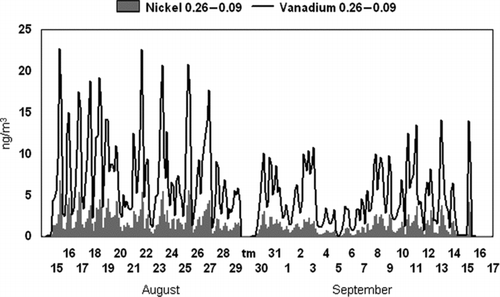
Laboratory data on the impact of vanadium and nickel aerosols has become more extensive (Zhang et al. Citation2009). Thus, we can hypothesize that the effective control of the crude-oil-derived metals in the late 1980s may be responsible for the decreased IHD death rate at sites north of Bakersfield in the 1990s and beyond. This hypothesis is supported by other studies, such as the sharp drop in mortality after a sharp drop in sulfur, vanadium, and nickel in Hong Kong when the sulfur levels in fuels were lowered by edict (Hedley et al. Citation2002; Lippmann et al. Citation2006). The presence of high levels of nickel in New York City from residual oil combustion in buildings is hypothesized to be a causal factor in the enhanced mortality associated with PM2.5 (Peltier et al. Citation2009; Peltier and Lippmann Citation2010).
The current data also have relevance to the emission of sulfur, vanadium, and nickel by oceangoing ships. Recent data in New York and New Jersey (Peltier et al. Citation2009), and the Port of Los Angeles (Cahill et al. Citation2009), show the impacts of oceangoing ships burning residual or bunker oil. In the Los Angeles study, the average concentrations of fine sulfur, vanadium, and nickel in the coastal town of Wilmington in August 2008 were 2565, 16, and 4.4 ng/m3, respectively (). Southern winds bring aerosols from the Port of Los Angeles into Wilmington routinely during part of each day (). Ultrafine particles were not collected in this study, so the actual values could have been significantly higher than these values. Thus, on the basis of the Bakersfield data, the enhanced rates of IHD are predicted in the area.
CONCLUSION
IHD mortality in the Central Valley of California, corrected for age, race, sex, and smoking, was almost 60% greater at the more polluted southern end of the Central Valley than the less polluted northern end in 1989–1991 despite similar meteorology and land use patterns throughout the Valley. A significant association, r 2 = 0.56, is seen between IHD mortality and PM10, but negligible correlation, r 2 < 0.05, is seen with stroke mortality. When PM10 data are converted to an estimated PM2.5 mass by using more recent measurements, these results are similar to other studies such as the “6 Cities” study (Dockery et al. Citation1993) in mortality increase per particulate mass; 1.9% mortality increase per μg/m3 of PM2.5 for “6 Cities,” while 1.8% mortality increase per μg/m3 of estimated PM2.5 for this study, despite major differences in meteorology and pollutant mix. No association was seen between CO and any health impact. Ozone was only weakly correlated with IHD and stroke. However, strong east-west ozone gradients were not corrected for in this work, and thus, these results for ozone must be viewed as merely indicative of the possible impacts.
The sharp reduction seen, when the IHD data were reexamined in the period 2003–2007, was coincident with a reduction in the high levels of vanadium (19 ng/m3) and nickel (38 ng/m3) due to oil field operations from before 1974 to after 1990, when new protocols were adopted. The vanadium and nickel levels in 2009 were close to the national average values, both roughly 1.9 ng/m3. The relatively smaller reduction in IHD rate in Bakersfield itself is associated with the continuing impacts of vehicular very fine and ultrafine metals (Cahill et al. Citation2010, this issue).
Acknowledgments
The authors wish to gratefully acknowledge the input and oversight of the project by the ALASET Health Effects Task Force under Jananne Sharpless, Chair, and Betty Turner, ALASET liaison, HETF members Tom Cahill, Mel Knight, Michael Lipsett, Ralph Propper, Marc Schenker, Steve Van den Eden, and Earl Withycombe, as well as the suggestions of William Wilson, US EPA. The authors also wish to gratefully acknowledge the financial support of the Sacramento Metropolitan Air Quality Management District under its CEO, Norm Covell, and the Yolo-Solano AQMD, under its CEO, Larry Greene. Finally, the authors wish to thank Ms. Jeanette Martin for her untiring assistance in designing and assembling the original report.
REFERENCES
- ADAM . 2010 . ADAM California Environmental Protection Agency—Air Resources Board, ADAM Data Summaries Retrieved from www.arb.ca.gov/adam
- Barone , J. B. , Cahill , T. A. , Eldred , R. A. , Flocchini , R. G. , Shadoan , D. J. and Dietz , T. M. 1978 . A Multivariate Statistical Analysis of Visibility Degradation at Four California Cities . Atmos. Environ. , 12 : 2213 – 2221 .
- Cahill , T. , Cliff , S. S. , Jimenez-Cruz , M. and Perry , K. 2003 . Aerosols by Size, Time, and Composition in Support of the Fresno Asthmatic Children's Environment Study, 2001 , Sacramento, CA : Final Report to the California Air Resources Board .
- Cahill , T. , Dutcher , D. , Clark , C. , Martin , J. , McCarthy , T. and Lipnick , D. 1998 . Comparison of Cardiac and Stroke Mortality to Carbon Monoxide, Ozone, and Particulate Air Pollutant Concentrations in the Sacramento Valley Region , Sacramento, CA : Report to the Health Effects Task Force, American Lung Association Sacramento Emigrant Trails .
- Cahill , T. A. 1995 . “ Compositional Analysis of Atmospheric Aerosols ” . In Particle-Induced X-Ray Emission Spectrometry (Chemical Analysis Series, Vol. 133) , Edited by: Johansson , S. A. E. , Campbell , J. L. and Malmqvist , K. G. 237 – 311 . John Wiley & Sons, Hoboken, NJ .
- Cahill , T. A. , Barnes , D. and Smeltzer , K. 2009 . Deposition of Coarse Toxic Particles in Wilmington, CA , Sacramento, CA : Final Report for the Department of Toxic Substances Control (DTSC) .
- Cahill , T. A. , Barnes , D. E. , Spada , N. J. , Lawton , J. A. and Cahill , T. M. 2010 . Very Fine and Ultra-Fine Metals and Ischemic Heart Disease in the California Central Valley 1: 2003–2007 . Aerosol Sci. Technol. , 45 : 1124 – 1134 .
- Cahill , T. A. , Eldred , R. A. , Motallebi , N. and Malm , W. C. 1989 . Indirect Measurement of Hydrocarbon Aerosols Across the United States by Non-Sulfate Hydrogen-Remaining Gravimetric Mass Correlations . Aerosol Sci. Tech. , 10 : 421 – 429 .
- Cahill , T. A. and Flocchini , R. G. 1974 . Regional Monitoring of Smog Aerosols, Annual Reports to the California Air Resources Board, Contract 2–006, 1974, 1975, 1976, 1977 Sacramento, CA
- California Department of Health Services . 2010 . California Department of Health Services: Center for Health Statistics Office of Health Information and Research (OHIR) Retrieved from http://www.dhs.ca.gov/hisp/chs/OHIR/vssdata/Tables.htm
- Kao , C. , Gazzinaga , J. M. , Cowling , D. W. , Cohen , R. D. , Fox , P. and Kaplan , G. A. , eds. September 1994 . Cardiovascular Disease Outreach and Epidemiology Program. The Local Burden of Cardiovascular Disease; Death from Heart Disease and Stroke in California Cities , San Francisco, CA : California Department of Health Services and the University of California . Report No. 1
- California Regional Particulate Air Quality Study (CRPAQS) . 2001 . California Regional Particulate Air Quality Study Retrieved from http://www.arb.ca.gov/airways
- Devlin , R. 2003 . What We Know and What We Think We Know About Health Effects of Fine Particles: Is It Enough? , Charlotte, NC : Annual Meeting. American Association of Aerosol Research (AAAR) .
- Dockery , D. W. , Pope , C. A. III , Hu , X. P. , Spengler , J. D. , Ware , J. H. , Fay , M. E. , Ferris , B. G. and Speizer , F. E. 1993 . An Association Between Air Pollution and Mortality in Six US Cities . N. Engl. J. Med. , 329 : 1725 – 1759 .
- Flocchini , R. G. , Cahill , T. A. , Shadoan , D. J. , Lange , S. J. , Eldred , R. A. , Feeney , P. J. , Wolfe , G. W. , Simeroth , D. C. and Suder , J. K. 1976 . Monitoring California's Aerosols by Size and Elemental Composition . Environ. Sci. Technol. , 10 : 76 – 82 .
- Hayes , T. P. , Kinney , J. J. R. and Wheeler , N. J. M. 1984 . “ California Surface Wind Climatology, State of California Air Resources Board, Aerometic Data Division ” . Sacramento, CA
- Hedley , A. J. , Wong , C.-M. , Thach , T. Q. , MStat , S. M. , Lam , T.-H. and Anderson , H. R. 2002 . Cardiorespiratory and All-Cause Mortality After Restrictions on Sulfur Content of Fuel in Hong Kong: An Intervention Study . Lancet , 360 ( 9346 ) : 1646 – 1652 .
- Interagency Monitoring of Protected Visual Elements (IMPROVE) . 2010 . Retrieved from http://vista.cira.colostate.edu/IMPROVE/
- Kao , C. , Gazzinaga , J. M. , Cowling , D. W. , Cohen , R. D. , Fox , P. and Kaplan , G. A. 1994 . “ Caralio Vascular Disease Outreach and Epidemiology Program. The Local Burden of Cardiovascular Disease; Death from Heart Disease and Stroke in California Cities. Report No. 1. California Department of Health Services and the University of California ” . San Francisco, CA
- Lippmann , M. 2009 . Semi-Continuous Speciation Analyses for Ambient Air Particulate Matter: An Urgent Need for Health Effects Studies . J. Expo. Sci. Epidemiol. Stud. , 19 : 235 – 247 .
- Lippmann , M. , Ito , K. , Hwang , J. S. , Maciejczyk , P. and Chen , L. C. 2006 . Cardiovascular Effects of Nickel in Ambient Air . Environ. Health Perspect. , 1141 ( 11 ) : 1662 – 1669 .
- Malm , W. C. , Sisler , J. F. , Huffman , D. , Eldred , R. A. and Cahill , T. A. 1994 . Spatial and Seasonal Trends in Particle Concentration and Optical Extinction in the United States . J. Geophys. Res. , 99 ( D1 ) : 1347 – 1370 .
- Motallebi , N. , Cahill , T. A. and Flocchini , R. G. 1990a . Influence of Particulate Size on Statistical Studies of Visibility at California Regions . Atmosfera , 3 ( 2 ) : 111 – 126 .
- Motallebi , N. , Flocchini , R. G. , Myrup , L. O. and Cahill , T. A. 1990b . A Principal Component Analysis of Visibility and Air Pollution in Six California Cities . Atmosfer. , 3 ( 2 ) : 127 – 141 .
- Neter , J. W. , Kutner , M. H. , Nachtsheim , C. J. and Wasserman , W. 1996 . Applied Linear Statistical Models , 4th ed. 353 Irwin, Chicago IL
- Peltier , R. E. , Hsu , S.-I. , Lall , R. and Lippmann , M. 2009 . Residual Oil Combustion: A Major Source of Airborne Nickel in New York City . J. Expo. Sci. Epidemiol. , 19 : 603 – 612 .
- Peltier , R. E. and Lippmann , M. 2010 . Residual Oil Combustion: 2. Distribution of Airborne Nickel and Vanadium Within New York City . J. Expo. Sci. Epidemiol. , 20 : 342 – 350 .
- Zhang , Z. , Chau , P. Y. , Lai , H. K. and Wong , C. M. 2009 . A Review of the Effects of Particulate Matter-Associated Nickel and Vanadium Species on Cardiovascular and Respiratory Systems . Int. J. Environ. Health Res. , 19 ( 3 ) : 175 – 185 .
